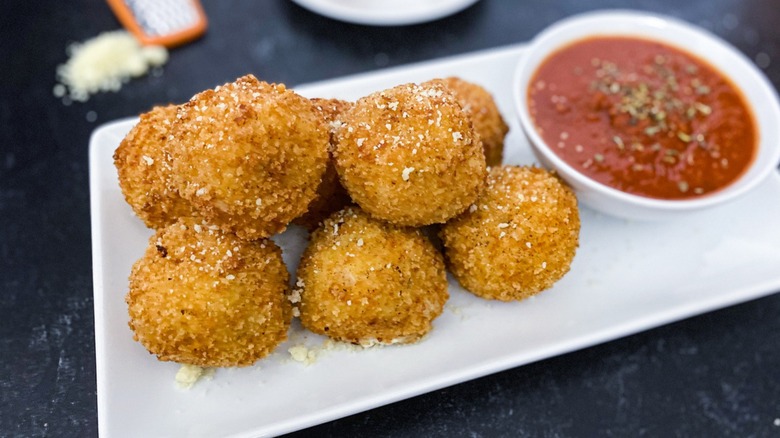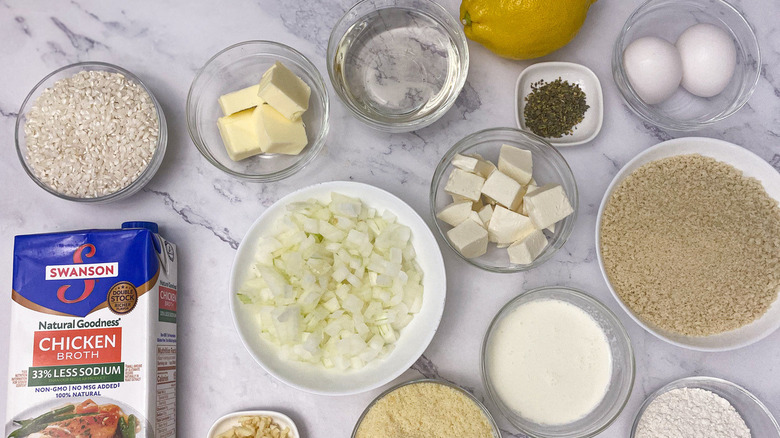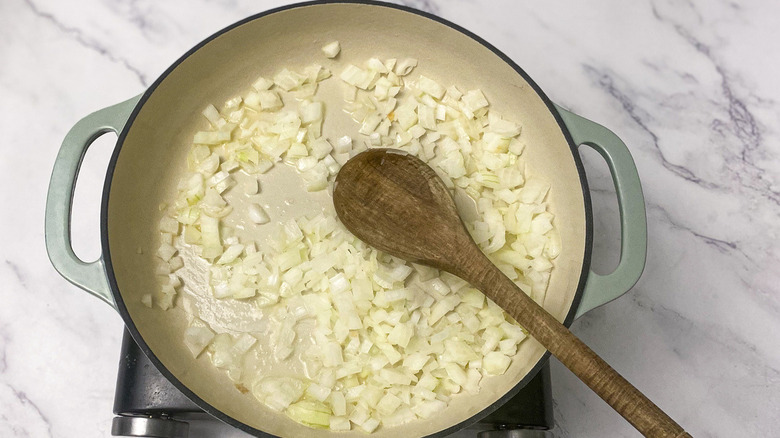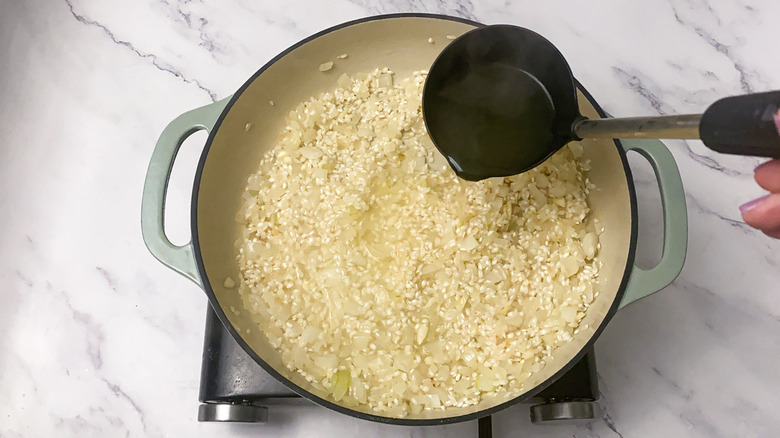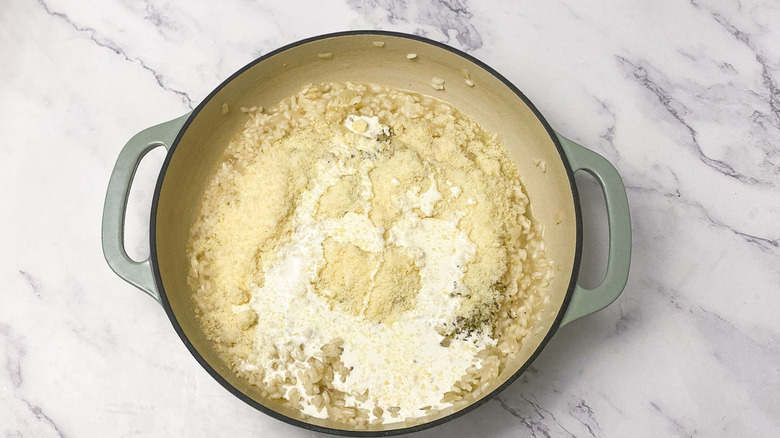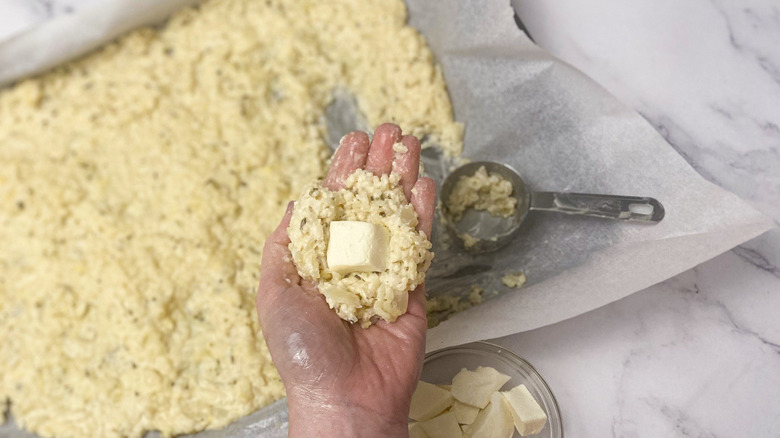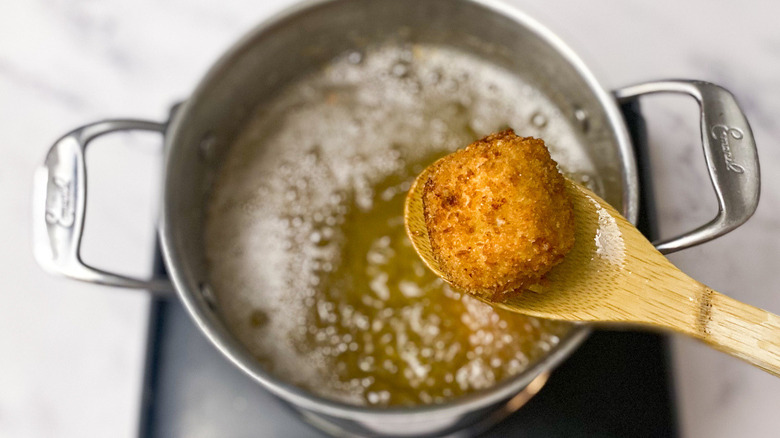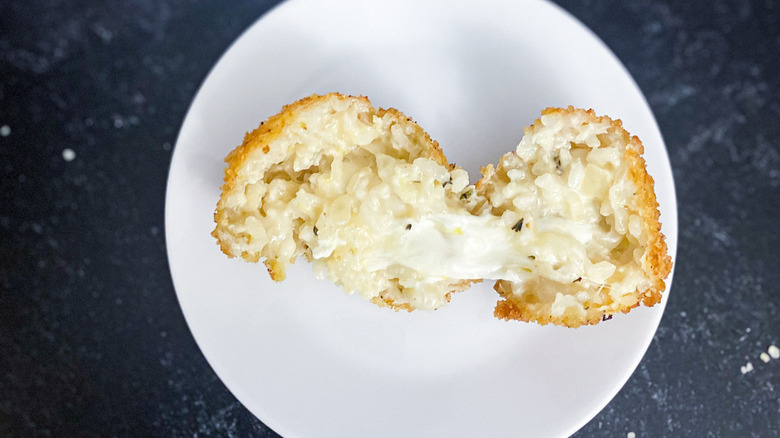Traditional Arancini Recipe
Arancini is a paradoxical food in that its name, in Italian, means "little oranges," yet the dish has no orange flavoring in it. Instead, the primary flavor in this dish consists of that Italian dynamic duo: mozzarella and Parmesan. Many people also like to serve arancini with a side of marinara for dipping.
This is an especially popular dish in Italy, and you'll find it at coffee shops, restaurants, and even little bakeries. And if you've ever eaten arancini at a restaurant or Italian bakery, you'll be sure to agree that they're a not-to-be-missed treat, especially for those who can't get enough carbs in their diet. While you might think arancini would be difficult to make at home, developer Erin Johnson provides a step-by-step recipe that breaks it down into doable tasks. With just a little bit of hard work, you could be eating this Italian classic at home in no time.
Assemble the arancini ingredients
To make these arancini, you're going to need a number of different ingredients, but none of them is anything too exotic or difficult to find. To make the risotto, you'll need chicken stock for cooking (bouillon cubes and water will do), butter, an onion, a few cloves of garlic, Arborio rice, white wine, Italian seasoning, Parmesan cheese (grate it yourself for the best flavor), heavy cream, a lemon (you'll use both the zest and the juice), and some salt and pepper.
Once the risotto is made, you'll make the arancini by coating it with flour, eggs, and panko breadcrumbs. You'll also need some mozzarella that you're going to cut into chunks, so buy a ball or block of the stuff. To fry the arancini, you should also have some oil on hand.
Simmer the stock as you sauté the veggies
Pour the chicken stock into a medium-sized saucepan and heat it until it starts to boil. Once the stock is boiling, turn the heat down to low and let it simmer while you turn your attention to the veggies. Get out a large skillet and use it to melt two tablespoons of butter. Add the chopped onion and cook it, stirring, until it's soft. At this point, add the garlic and cook it with the onions for about 30 seconds.
Add the liquid to the rice a bit at a time
Once the garlic is starting to smell nice and garlicky, it's time to add the rice to the pan. Cook it until it starts to turn clear around its edges, at which point you should add the wine. Stir it in, then cook the rice for about five minutes until the wine has been absorbed.
Now add one cup of the stock and cook, stirring, for another five minutes until this liquid has also been absorbed. Repeat this with the next cup of stock and the next, and then one more time with the remaining half cup of stock. Each time you add more liquid, cook and stir until the latest batch of liquid gets absorbed into the rice. After there's no more liquid left, cook the rice for 10 more minutes or until the rice is soft and tender.
Season the risotto before letting it rest
Take the skillet off the heat and stir in the Italian seasoning, Parmesan cheese, cream, lemon zest, and lemon juice. Mix all of these ingredients together well, then taste the risotto. Add as much salt and pepper as you think it needs.
Once the risotto is seasoned to your satisfaction, spread it out over a parchment-covered or greased baking sheet. Place the sheet in the fridge and let the risotto cool down for an hour or so.
Form the risotto into balls
Scoop up a quarter cup of the risotto and flatten it in the palm of your hand. Place a cube of mozzarella in the center of the risotto and form a ball around it. Repeat forming these rice/cheese balls until you use up all of the risotto, at which point you should have 12 arancini. Dredge the risotto balls in flour, then dip them in the beaten egg and coat them with the panko.
Johnson tells us that you can also take a shortcut straight to this step of the recipe. "If you already have risotto," she says, "this is a great way to use it! Just pick up with making the balls, and skip making your own risotto." She says you can use either homemade or packaged or frozen risotto, although you should let it cool (or thaw) before using it to make the arancini.
Fry the arancini and serve them hot
Once all the arancini balls are ready, you can start heating up the oil in the pot. If you're wondering how much oil to use, Johnson says, "The best way to know it is to measure the height of the rice balls and then use that amount of oil in the pot. For me, that is about two and a half inches."
While you could heat the oil while you make the balls, it's best not to take your eye off the temperature since oil that gets too hot can pose a serious fire risk. You should definitely use a deep fry thermometer to check the oil temperature too. Once the oil hits 360 degrees, you can start frying, but don't let it get any hotter than that. Fry the balls in small batches until they are golden brown in color, which Johnson says should take between four to six minutes.
Johnson also says you can fry the arancini in an air fryer if you wish. Preheat the air fryer to 360 degrees, then when the balls are in the basket, spray them lightly with oil and cook them for six minutes. If they're not crispy enough, you might want to turn up the heat to 400 degrees and finish them off with another two to three minutes of cooking.
Arancini can be an appetizer or a meatless main course
Arancini, as Johnson tells us, are "usually an appetizer," but she says they "can absolutely be a main dish." She does say, though, that "they are quite heavy, so I like to serve them with a salad." You could also serve arancini as a side dish with Italian sausages or chicken Parmesan in lieu of pasta. They wouldn't go so well with a pasta dish, however, since rice plus pasta equals carb overload.
Johnson suggests you can also tweak these arancini to suit your preferences. "If you want to change the flavors," she says, "you can easily add different seasonings to the risotto." She also allows, "Feel free to substitute another cheese or even add meat to the centers," telling us, "It may not be traditional, but it's equally delicious."
Traditional Arancini Recipe Directions
Arancini is a paradoxical food in that its name, in Italian, means "little oranges," yet the dish has no orange flavoring in it.
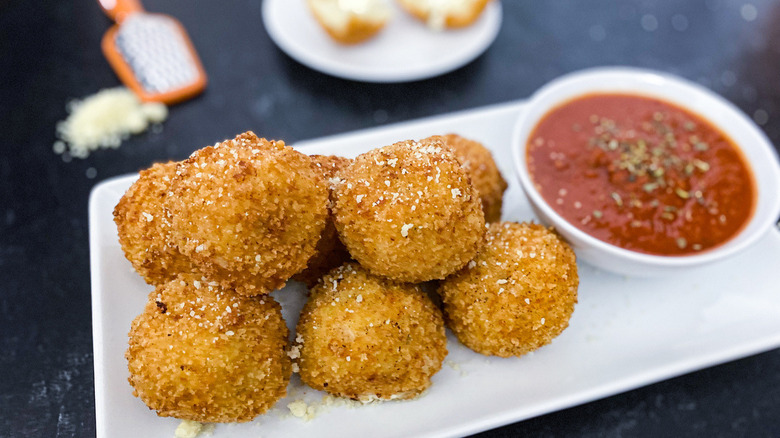
Ingredients
- 3 1/2 cups chicken stock
- 4 tablespoons butter, divided
- 1 onion, minced
- 3 cloves garlic, minced
- 1 cup Arborio rice
- 1/2 cup white wine
- 1 teaspoon Italian seasoning
- 1 cup grated Parmesan
- 1/4 cup heavy cream
- Zest of 1 lemon
- 2 tablespoons lemon juice
- Salt and pepper to taste
- 4 ounces mozzarella, sliced into 12 cubes
- 1 cup flour
- 2 eggs, beaten
- 2 cups panko
- Oil for frying
Optional Ingredients
- Marinara sauce, for dipping
Directions
- In a saucepan, heat the chicken stock until boiling, then reduce to a simmer.
- In a large skillet, melt 2 tablespoons of butter. Add the onion and cook until softened. Add the garlic.
- Add the rice to the skillet and cook until the rice begins to turn clear around the edges.
- Add the wine and stir. Allow the rice to cook until the liquid has been absorbed, approximately 5 minutes.
- Add 1 cup of stock to the skillet, stir and allow to cook, stirring frequently, until the liquid is absorbed, approximately 5 minutes.
- Repeat with the remaining stock until you've used it all up, cooking for about 5 minutes each time to absorb the liquid.
- After all of the liquid is absorbed, cook the rice for an additional 10 minutes or until it's tender.
- Remove the skillet from the heat and add the Italian seasoning, Parmesan, cream, lemon zest, and lemon juice. Stir to combine. Season the rice mix with salt and pepper to taste.
- Pour the risotto onto a parchment-covered baking sheet and refrigerate for one hour.
- Scoop out a small portion of risotto and flatten it in the palm of your hand. Put a cube of mozzarella in the center and form a ball around the cheese. Repeat until you use all of the risotto.
- Dredge the risotto balls in flour, then beaten egg, then panko.
- Heat oil in a pot until it reaches 360 degrees.
- Fry the rice balls in the hot oil in batches until they are golden brown, which should take 4 to 6 minutes.
- Serve arancini warm with marinara sauce, if desired.
Nutrition
| Calories per Serving | 447 |
| Total Fat | 28.2 g |
| Saturated Fat | 8.5 g |
| Trans Fat | 0.2 g |
| Cholesterol | 61.6 mg |
| Total Carbohydrates | 33.9 g |
| Dietary Fiber | 1.6 g |
| Total Sugars | 2.6 g |
| Sodium | 441.6 mg |
| Protein | 12.7 g |
